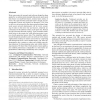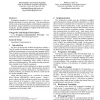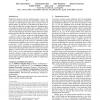SENSYS
2006
ACM
15 years 6 months ago
2006
ACM
Most sensor network research and software design has been guided by an architectural principle that permits multi-node data fusion on small-form-factor, resource-poor nodes, or mo...
100
click to vote
SENSYS
2006
ACM
15 years 6 months ago
2006
ACM
It is vital to support concurrent applications sharing a wireless sensor network in order to reduce the deployment and administrative costs, thus increasing the usability and efļ¬...
84
Voted
SENSYS
2006
ACM
15 years 6 months ago
2006
ACM
SENSYS
2006
ACM
15 years 6 months ago
2006
ACM
Distributed estimation of sensor location is a key enabling technology for sensor networks. This demonstration will provide an interactive display of distributed, cooperative loca...
SENSYS
2006
ACM
15 years 6 months ago
2006
ACM
SENSYS
2006
ACM
15 years 6 months ago
2006
ACM
158
Voted
SENSYS
2006
ACM
15 years 6 months ago
2006
ACM
We explore fundamental performance limits of tracking a target in a two-dimensional ļ¬eld of binary proximity sensors, and design algorithms that attain those limits. In particul...
SENSYS
2006
ACM
15 years 6 months ago
2006
ACM
Small-form-factor, low-power wireless sensorsāmotesāare convenient to deploy, but lack the bandwidth to capture and transmit raw high-frequency data, such as human voices or n...
127
click to vote
SENSYS
2006
ACM
15 years 6 months ago
2006
ACM
Introducing mobile data sinks into wireless sensor networks (WSNs) improves the energy efļ¬ciency and the network lifetime, and is demanded for many application scenarios, such a...
102
Voted
SENSYS
2006
ACM
15 years 6 months ago
2006
ACM
Science is increasingly driven by data collected automatically from arrays of inexpensive sensors. The collected data volumes require a different approach from the scientists'...




